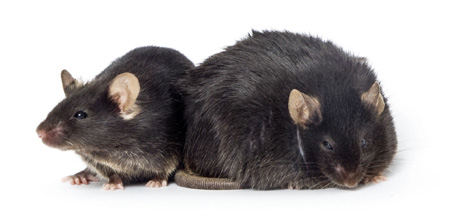IL6 and TNF necessary for tumorigenesis
It is well established that obesity is a risk factor for many diseases, including diabetes, heart disease, stroke and cancer. Its association with the common liver cancer known as hepatocellular carcinoma (HCC) has become increasingly apparent. However, the biological mechanisms by which obesity increases HCC risk have been an unsolved puzzle. Recently, a research team from the School of Medicine, University of California, San Diego, put at least one piece of the puzzle in place. They demonstrated that obesity, whether genetically or diet-induced, promotes HCC in mice by increasing the production of two tumor-promoting cytokines – interleukin 6 (IL6) and tumor necrosis factor (TNF). The increased production of both cytokines is an inflammatory response triggered by the accumulation of fat in the liver (hepatosteatosis) and activates the oncogenic transcription factor STAT3. The authors suggested that increased production of IL6 and TNF also causes other cancers.
Too much fat in the world
Approximately two-thirds of US adults and 300 million people worldwide are overweight or obese, and the numbers are increasing. In men and women, obesity increases the risk of any type of cancer-related death by up to 1.52- to 1.62-fold respectively, but the risk is highest for HCC: Obese men may increase their risk by up to 4.52-fold. Even being moderately overweight significantly increases the risk of dying from liver, pancreatic, gastrointestinal and kidney cancers (Calle et al. 2003, 2004).
In addition to being associated with obesity, HCC is associated with hepatosteatosis, which is often accompanied by a severe complication known as nonalcoholic fatty liver disease (NAFLD), affecting up to 24% of U.S. citizens (Parekh and Anania 2007). Together, obesity and NAFLD may be as important in causing HCC as is the hepatitis C virus (HCV), the major HCC risk factor in the U.S. and Japan (Caldwell et al. 2004; El-Serag and Rudolph 2007).
It was these associations – between being overweight or obese and HCC risk and between hepatosteatosis and HCC risk – that prompted the University of California School of Medicine team to investigate the mechanisms by which obesity causes HCC.
Key study results
Either diet- or genetically induced obesity causes HCC in mice. HCC may be induced in mice by pre-conditioning them with the hepatic procarcinogen diethylnitrosamine (DEN) and then feeding them a high-fat diet (HFD). The researchers validated the DEN model by feeding some C57BL/6J mice, which do not spontaneously develop liver disease or cancer, with an HFD and some with a low-fat diet (LFD). They found that both sexes of DEN-pre-conditioned B6J mice fed an HFD are far more susceptible to HCC than controls fed an LFD. They also found that the tumor-promoting effect of HFD-induced obesity is at least as strong as that of phenobarbital (PB), a known liver carcinogen.
Obese mice are significantly more susceptible to liver cancer than are lean mice.

Obesity accelerates cancer cell proliferation in mice. To determine the effect of obesity on cancer cell proliferation, the researchers transplanted HCC tumor cells into two-month old B6J mice and then fed them either an LFD or HFD for four weeks. They inoculated the same number of HCC cells into eight-month old B6J mice fed an HFD for the preceding six months or into Lepob mice. In all cases, the more obese the mice, the faster the tumors grew, the largest growing in Lepob mice. Additionally, to inhibit STAT3 activation, the researchers treated some of the mice with the JAK inhibitor AG490 and found that it inhibits tumor growth most in two-month old B6J mice fed an HFD, and that it also inhibits STAT3 phosphorylation in these mice.
Obesity activates a number of signaling pathways that mediate HCC in obese mice. The researchers found that obese mice exhibit elevated levels of IL6 (a powerful activator of the oncogenic transcription factor STAT3), TNF and IL1b, increased phosphorylation of STAT3, ERK, and the mTOR target S6 kinase and its substrate ribosomal protein S6, and an increased number of macrophages and other leukocytes.
IL6 and TNF receptor are required for HCC pathogenesis in mice. The researchers tested the role of IL6 and TNF in HCC development. They found that IL6-deficient and TNFR1A-deficient mice (B6.129S2-Il6tm1Kopf/J, and C57BL/6-Tnfrsf1atm1Imx/J, respectively) are protected from obesity-induced HCC. In these mice, either IL6 or TNF deficiency reduces or prevents the activation of the HCC-mediating signaling pathways mentioned above.
In summary, the researchers concluded that either diet- or genetically induced obesity in mice greatly increases HCC susceptibility (and perhaps other cancers) by triggering an inflammatory response (mediated by both IL6 and TNF) to hepatosteatosis. Their findings may provide molecular targets for preventing or treating obesity-induced HCC in humans.
References
Caldwell SH, Crespo DM, Kang HS, Al-Osaimi AM. 2004. Obesity and hepatocellular carcinoma. Gastroenterology 127:S97-103.
Calle EE, Rodriguez C, Walker-Thurmond K, Thun, MJ. 2003. Overweight, obesity, and mortality from cancer in a prospectively studied cohort of U.S. adults. N Engl J Med 348:1625-38.
Calle EE, Kaaks R. 2004. Overweight, obesity and cancer: epidemiological evidence and proposed mechanisms. Nat Rev Cancer 4:579-91.
El-Serag HB and Rudolph KL. 2007. Hepatocellular carcinoma: epidemiology and molecular carcinogenesis. Gastroenterology 132:2557-76.
Parekh S and Anania FA 2007. Abnormal lipid and glucose metabolism in obesity: implications for nonalcoholic fatty liver disease. Gastroenterology 132:2191-2207.
Park EJ, Lee JH, Yu G-Y, He G, Ali SR, Holzer RG, …sterreicher CH, Takahashi H, Karin M. 2010. Dietary and Genetic Obesity Promote Liver Inflammation and Tumorigenesis by Enhancing IL-6 and TNF Expression Cell 140:197-208.